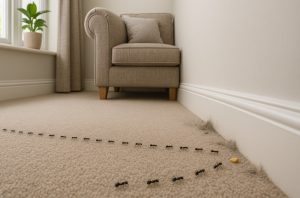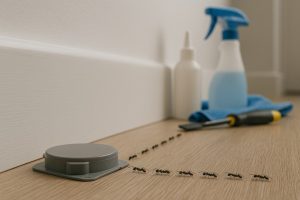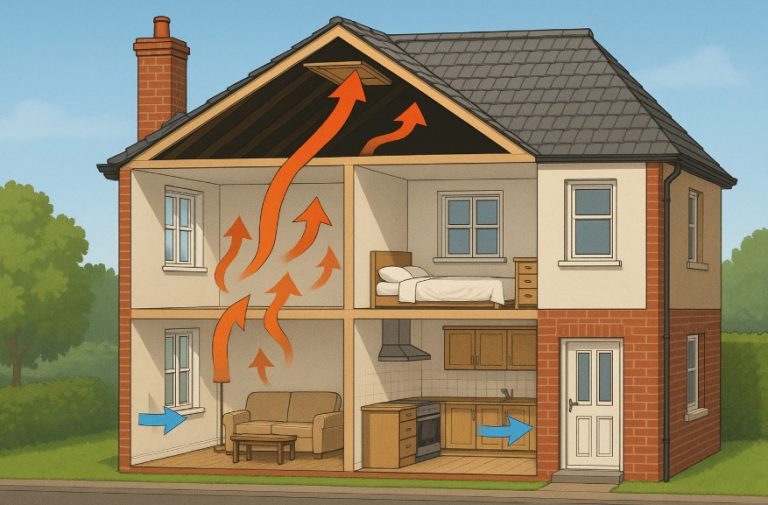Ants are one of the most common household pests in the UK, especially during warmer months. While not typically dangerous, they can become a significant nuisance once they find access to food and shelter indoors.
Whether it’s a trail of sugar ants invading your kitchen or a nest forming behind your walls, quick and effective action is essential.
This guide explores proven strategies to eliminate ants from your home efficiently, using both natural and professional methods.
What Are the Common Signs of an Ant Infestation Indoors?

Identifying an ant infestation early is crucial for preventing a larger problem. In many UK homes, ant infestations often start subtly and go unnoticed until they escalate.
Understanding the common signs can help residents take swift action and avoid long-term issues.
One of the first and most obvious indicators is the sighting of live ants, particularly in areas like kitchens, bathrooms or utility rooms.
Ants are social insects that operate in colonies, so even a few visible ants are rarely alone. If ants are observed repeatedly along the same route or congregating around food sources, it is a strong sign of an established trail leading back to a nest.
Trails of Ants
Ants use pheromones to mark paths between their nest and food sources. These scent trails allow other ants to follow the same route with precision. In indoor settings, these trails can appear:
- Along baseboards and skirting
- Across countertops or kitchen units
- From wall cavities into pantry areas
- Underneath sinks and near plumbing lines
Even if the trail appears to be inactive at times, ants often return during specific periods, particularly in the early morning or evening hours when there is less human activity.
Presence of Ant Nests Indoors
Though many ant species prefer nesting outdoors, some will establish colonies within the home, especially in warm and moist environments. A nest might look like a small pile of dirt or sawdust, commonly located near:
- Wall voids or electrical sockets
- Behind cupboards or kitchen appliances
- Under floorboards or tiles
- Around boiler rooms or airing cupboards
Pharaoh ants and Argentine ants are known to favour nesting inside heated buildings, making them more problematic in modern UK flats and apartment complexes.
Small Piles of Soil or Frass
Another telltale sign is the presence of fine soil or debris indoors. This is often mistaken for general dust or dirt but may indicate that ants are tunnelling within woodwork, brickwork or insulation.
These deposits might appear:
- Near skirting boards or the junction of walls and floors
- Around windowsills and door frames
- In corners of rooms that are seldom cleaned
In some cases, these piles may contain discarded insect body parts or ant droppings, which are left behind as the colony grows or moves.
Unusual Pet Behaviour
Pets often detect ant activity before humans do. Dogs or cats may show interest in specific corners, underneath furniture or near food bowls.
They might paw at or sniff areas where ants are active, providing early warning signs of an infestation.
Rustling or Movement Sounds Within Walls
While not typical for all species, in quieter environments some homeowners have reported hearing faint rustling sounds from walls or ceilings when a large colony is active.
This is more likely with species like carpenter ants or Argentine ants, which build expansive tunnel systems behind walls or in structural voids.
Ants Around Food and Water Sources
Any consistent presence of ants near food or moisture should be a red flag. Kitchens and bathrooms are hotspots due to:
- Uncovered sugar, honey, or syrup
- Pet food left out for extended periods
- Leaky taps or condensation
- Overflowing bins or unclean compost caddies
Ants are particularly drawn to sugary substances, but protein-rich foods (such as meat and grease) can also attract certain species like Pharaoh ants.
Winged Ants or Swarmers
During late spring and summer, many ant colonies produce winged ants, also known as alates or swarmers.
These are reproductive ants that emerge to mate and establish new colonies. A sudden appearance of dozens or hundreds of winged ants inside your home suggests that a nest may be present within or very near the property.
This event is often referred to as “Flying Ant Day” in the UK and typically occurs after warm, rainy days. It should not be ignored, as it often precedes the formation of new nests.
What Immediate Steps Can You Take to Get Rid of Ants Quickly?

When ants are spotted inside the home, immediate action can significantly limit their spread and reduce the likelihood of a larger infestation.
Quick intervention also disrupts the communication pathways ants rely on to locate food and guide other members of the colony. The following measures are practical and effective for most household situations.
Thorough Cleaning and Elimination of Food Sources
The most critical step is to remove the ants’ access to food and water. Ants are primarily driven by the need to forage, and even the smallest crumbs or residues can sustain a colony.
Key cleaning actions include:
- Wiping down all surfaces with vinegar or citrus-based cleaning sprays
- Sweeping or hoovering floors to remove crumbs and debris
- Washing dishes promptly after use rather than leaving them in the sink
- Rinsing recyclable containers before placing them in the bin
- Keeping pet food dishes clean and storing kibble in sealed containers
It’s also important to regularly disinfect high-traffic areas like kitchen counters, cupboard doors and under appliances, as ants leave pheromone trails that encourage more ants to follow the same paths.
Identifying and Sealing Entry Points
Ants are expert infiltrators and can enter through the tiniest of gaps. Once they’ve identified a reliable entry point, they will continue to use it unless it’s blocked.
Sealing these gaps is essential to stop more ants from entering once the active trail has been disrupted.
Common entry points include:
- Cracks around windows and doors
- Gaps beneath skirting boards and floor tiles
- Spaces around utility pipes, cables or wall penetrations
- Vents or extractor fan covers
Homeowners should use silicone caulk or acrylic sealant to close cracks in walls, frames, and around pipework. For older homes, draught-proofing tapes and door sweeps can also prevent ants from accessing rooms.
Disrupting Scent Trails
Ants communicate primarily through pheromone trails, which act like invisible roadmaps for others in the colony. Disrupting these trails is one of the fastest ways to prevent more ants from finding food sources inside.
Effective methods to erase these trails include:
- Spraying affected surfaces with a 1:1 mixture of white vinegar and water
- Wiping along ant trails with lemon juice
- Using commercial surface sprays that contain mild insect-repellent properties
Removing the trail breaks the ants’ sense of direction and forces them to search randomly, which often causes them to abandon the route altogether.
Deploying Quick-Action Remedies
While long-term control may involve baits or professional pest control, some remedies provide fast results for visible ant activity.
Useful quick-response options include:
- Ant powders: Sprinkle directly onto visible trails or around entry points. These work by dehydrating ants and disrupting their exoskeletons.
- Boiling water: For outdoor nests near the foundation or paving, pouring boiling water directly into the nest entrance can kill large numbers of ants instantly.
- DIY sprays: Create a homemade repellent with water, vinegar and essential oils like peppermint or tea tree, and spray it around affected areas.
However, it’s important to apply these treatments with care, especially in homes with children or pets. Always ensure areas are well ventilated and cleaned after treatment to remove any residues.
Isolating the Problem Area
Limiting the ants’ access to the rest of the house can help contain the infestation while more comprehensive treatments take effect. If ants are concentrated in one room (such as the kitchen), keeping doors closed and placing deterrents along thresholds can prevent them from spreading.
Simple isolation techniques:
- Use double-sided tape at doorways and window sills to deter ants from crossing
- Keep lights off at night in infested rooms, as some species are nocturnal foragers
- Avoid leaving food out overnight, including fruit bowls and baked goods
By acting swiftly and implementing these steps within the first 24 to 48 hours of spotting an ant trail, most minor infestations can be significantly reduced or eradicated. For more serious or recurring problems, these methods can provide valuable short-term relief while longer-term solutions are being arranged.
Are Natural Ant Repellents Effective for Quick Results?

Natural repellents are often effective in low-level infestations and pose minimal risk to children and pets. They offer a non-toxic way to disrupt ant activity.
Which Natural Substances Repel Ants Effectively?
Some ingredients found in most kitchens can deter ants when applied correctly.
- White vinegar mixed with water eliminates scent trails
- Lemon juice acts as an acidic barrier at entry points
- Coffee grounds placed near entryways confuse scent detection
- Cinnamon or cayenne pepper sprinkled along ant trails discourages movement
These substances can be used alongside routine cleaning to create a layered defence.
How Can Essential Oils Help in Ant Control?
Essential oils such as peppermint and eucalyptus can overwhelm the ants’ sensory receptors. When diluted and sprayed around the home, they act as effective natural deterrents.
Recommended oils include:
- Peppermint oil: Strongly scented and repels most insects
- Tea tree oil: Disrupts scent trails and has mild insecticidal properties
- Eucalyptus oil: Antiseptic and effective against most ant species
Combine 10–15 drops of essential oil with water in a spray bottle and apply to windowsills, door frames, and other affected areas.
What Chemical or Store-Bought Solutions Work Best?
For larger or persistent infestations, commercial treatments offer stronger results. Many of these products are designed for quick action and longer-lasting protection.
How Do Ant Baits and Gels Work?
Ant bait stations and gel applications contain slow-acting insecticides disguised as food. Foraging ants bring this poisoned bait back to the nest, eventually killing the entire colony.
Key benefits include:
- Easy placement along ant trails
- Continuous exposure over several days
- Reduced need for widespread chemical spraying
They are especially useful in locations where nests are hidden or inaccessible.
Are Insecticide Sprays Safe for Indoor Use?
Modern insecticide sprays are designed for domestic environments, but it’s still important to use them responsibly. Most sprays are applied directly to visible trails or around entry points.
Sprays provide instant results, but only on the ants present at the time of application. They may not reach the colony unless paired with other methods.
Follow label instructions carefully and ventilate treated rooms after application.
When Should You Call a Professional Pest Control Service?

If ants return after repeated treatments or appear in multiple locations across the home, professional help is advised. Pest control specialists have access to stronger products and advanced detection tools.
How Do Professionals Identify and Eliminate Ant Colonies?
Professional pest technicians inspect the property to determine:
- The species of ant involved
- Entry points and trail patterns
- Nest locations and colony size
Based on this assessment, targeted treatments such as baiting, spraying, or dusting are applied. Some providers also use thermal imaging or monitoring stations to track hidden nests.
What Are the Long-Term Benefits of Expert Pest Control?
Professional services go beyond temporary fixes by offering:
- Scheduled follow-up treatments
- Guidance on long-term prevention
- Access to commercial-grade pesticides
- Reduced risk of reinfestation
Their experience ensures a more thorough and safe resolution to the problem.
How Can You Prevent Ants from Returning?
Ongoing prevention is vital to keep your home ant-free once the initial infestation is addressed.
What Daily Habits Can Keep Your Home Ant-Free?
Incorporating small daily routines into your household management can deter ants effectively.
- Rinse dishes and wipe counters immediately after meals
- Keep bins closed and emptied regularly
- Don’t leave pet food out overnight
- Store sweet foods in tightly sealed containers
How Does Proper Home Maintenance Help?
Maintaining your property structurally also plays a key role. Fixing leaks, clearing gutters and sealing entry points makes your home less inviting to pests.
What Is the Most Effective Way to Kill Ants in the House Fast?

If rapid elimination is required, a multi-method approach combining several fast-acting tools is most effective.
Which Methods Offer Immediate Results?
| Method | Speed | Best Used For | Limitations |
| Insecticide Spray | Fast | Visible ants on surfaces | Doesn’t reach hidden colonies |
| Boiling Water on Nest | Fast | Outdoor nests or garden areas | Can damage surrounding property |
| Commercial Bait Stations | Medium | Large-scale infestations | Takes a few days to work |
| Diatomaceous Earth Powder | Medium | Cracks, corners, behind appliances | Needs dry environment |
Combining bait traps with surface sprays helps address both immediate threats and the underlying nest. Natural repellents can also be layered for additional protection.
Are Fast Methods Always the Best Solution?
Not necessarily. Fast solutions often treat the symptom rather than the root cause. Eliminating foragers might reduce sightings, but without killing the colony, the infestation will return. For lasting results, use quick methods alongside targeted colony treatments or professional intervention.
Conclusion
Getting rid of ants in the house quickly requires a combination of fast-acting solutions and long-term prevention strategies.
From natural repellents to professional pest control services, each method serves a specific purpose depending on the severity of the infestation.
By maintaining cleanliness, sealing entry points, and acting promptly, homeowners in the UK can effectively manage and prevent ant problems. Staying vigilant and proactive is the key to keeping your living space pest-free all year round.
FAQs About Quickly Getting Rid of Ants Indoors
How long does it take for ant bait to work?
Typically, ant baits start affecting the colony within 24–48 hours, with full elimination taking a few days to a week, depending on the size of the infestation.
Can ants cause structural damage to a property?
While most household ants are harmless, species like carpenter ants can burrow into wooden structures, causing long-term damage if left unchecked.
Are ultrasonic pest repellers effective against ants?
Evidence is inconclusive. While some users report success, there’s no strong scientific backing for ultrasonic devices’ effectiveness against ants.
Should I remove ant trails after using bait?
No. Let ants carry the bait back to the colony. Clean the trails only after you’re sure the infestation is gone.
Are homemade ant traps safe for pets?
Some natural traps (like vinegar and lemon) are safe. However, avoid placing borax-based traps in areas accessible to pets.
Why do ants keep coming back even after cleaning?
They may have established a hidden colony inside or nearby. Persistent trails indicate the need for deeper intervention like professional pest control.
What time of year are ants most active in the UK?
Ant activity peaks during the spring and summer months, typically from April to September, depending on the weather.






